MERCEDES-BENZ CL CLASS 2010 Owners Manual
Manufacturer: MERCEDES-BENZ, Model Year: 2010, Model line: CL CLASS, Model: MERCEDES-BENZ CL CLASS 2010Pages: 500, PDF Size: 9.32 MB
Page 221 of 500
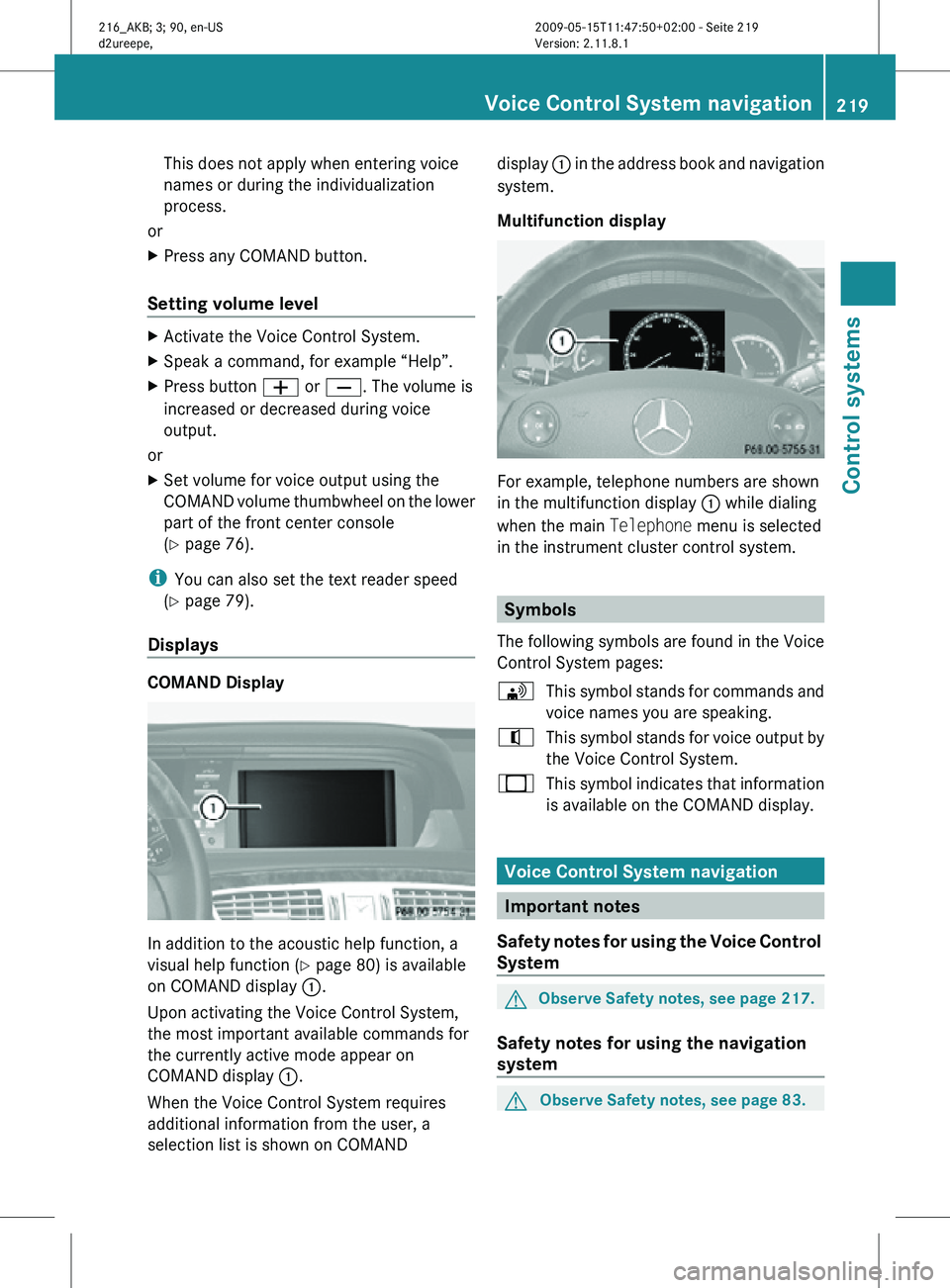
This does not apply when entering voice
names or during the individualization
process.
or
X Press any COMAND button.
Setting volume level X
Activate the Voice Control System.
X Speak a command, for example “Help”.
X Press button W or X. The volume is
increased or decreased during voice
output.
or
X Set volume for voice output using the
COMAND volume thumbwheel on the lower
part of the front center console
(Y page 76).
i You can also set the text reader speed
(Y page 79).
Displays COMAND Display
In addition to the acoustic help function, a
visual help function (Y page 80) is available
on COMAND display
:.
Upon activating the Voice Control System,
the most important available commands for
the currently active mode appear on
COMAND display :.
When the Voice Control System requires
additional information from the user, a
selection list is shown on COMAND display
: in the address book and navigation
system.
Multifunction display For example, telephone numbers are shown
in the multifunction display
: while dialing
when the main Telephone menu is selected
in the instrument cluster control system. Symbols
The following symbols are found in the Voice
Control System pages:
\ This symbol stands for commands and
voice names you are speaking.
^ This symbol stands for voice output by
the Voice Control System.
_ This symbol indicates that information
is available on the COMAND display. Voice Control System navigation
Important notes
Safety notes for using the Voice Control
System G
Observe Safety notes, see page 217.
Safety notes for using the navigation
system G
Observe Safety notes, see page 83. Voice Control System navigation
219Control systems
216_AKB; 3; 90, en-US
d2ureepe, Version: 2.11.8.1 2009-05-15T11:47:50+02:00 - Seite 219 Z
Page 222 of 500
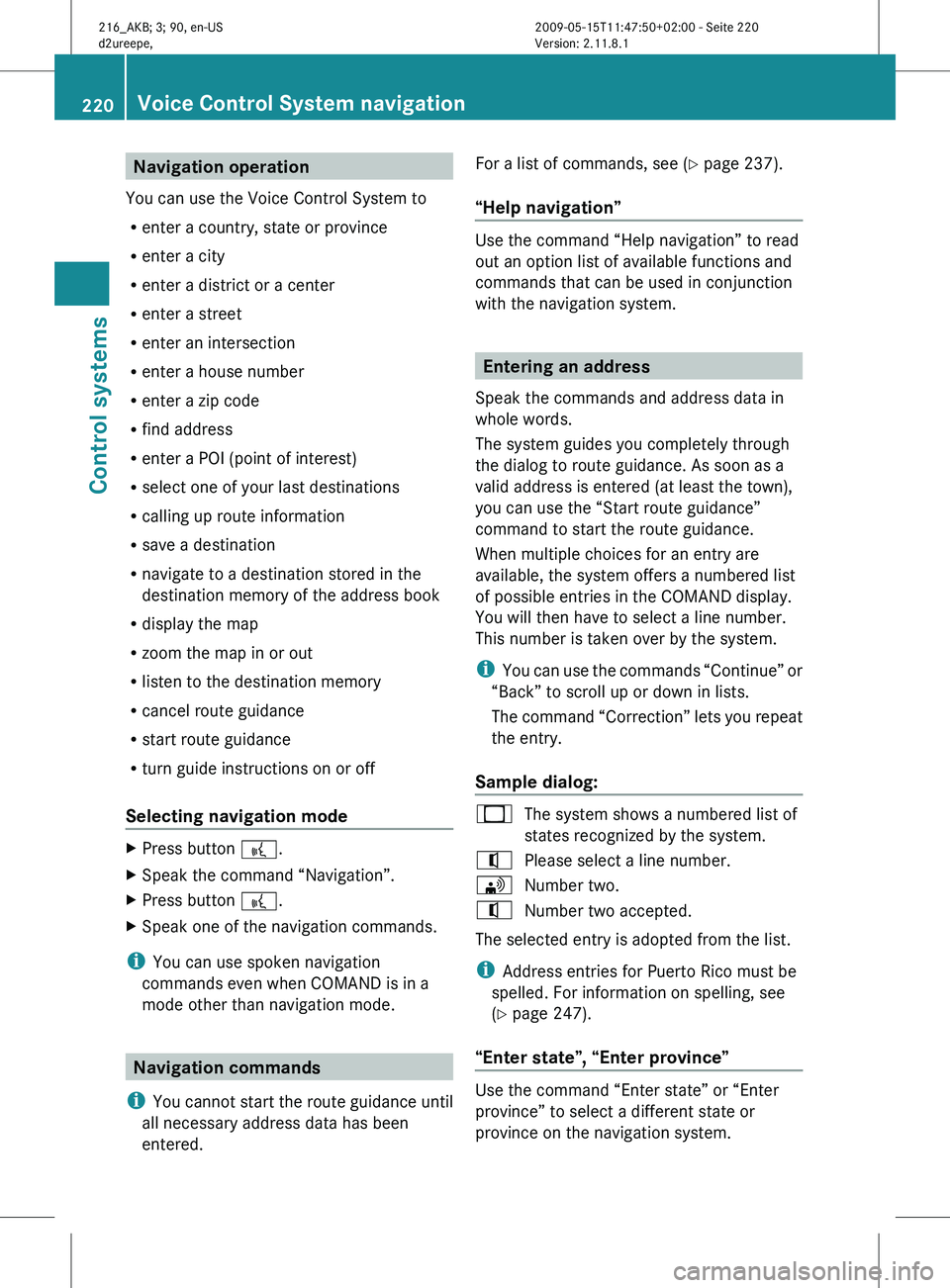
Navigation operation
You can use the Voice Control System to
R enter a country, state or province
R enter a city
R enter a district or a center
R enter a street
R enter an intersection
R enter a house number
R enter a zip code
R find address
R enter a POI (point of interest)
R select one of your last destinations
R calling up route information
R save a destination
R navigate to a destination stored in the
destination memory of the address book
R display the map
R zoom the map in or out
R listen to the destination memory
R cancel route guidance
R start route guidance
R turn guide instructions on or off
Selecting navigation mode X
Press button ?.
X Speak the command “Navigation”.
X Press button ?.
X Speak one of the navigation commands.
i You can use spoken navigation
commands even when COMAND is in a
mode other than navigation mode. Navigation commands
i You cannot
start the route guidance until
all necessary address data has been
entered. For a list of commands, see (
Y page 237).
“Help navigation” Use the command “Help navigation” to read
out an option list of available functions and
commands that can be used in conjunction
with the navigation system.
Entering an address
Speak the commands and address data in
whole words.
The system guides you completely through
the dialog to route guidance. As soon as a
valid address is entered (at least the town),
you can use the “Start route guidance”
command to start the route guidance.
When multiple choices for an entry are
available, the system offers a numbered list
of possible entries in the COMAND display.
You will then have to select a line number.
This number is taken over by the system.
i You can
use the commands “Continue” or
“Back” to scroll up or down in lists.
The command “Correction” lets you repeat
the entry.
Sample dialog: _
The system shows a numbered list of
states recognized by the system.
^ Please select a line number.
\ Number two.
^ Number two accepted.
The selected entry is adopted from the list.
i Address entries for Puerto Rico must be
spelled. For information on spelling, see
(Y page 247).
“Enter state”, “Enter province” Use the command “Enter state” or “Enter
province” to select a different state or
province on the navigation system.220
Voice Control System navigation
Control systems
216_AKB; 3; 90, en-US
d2ureepe,
Version: 2.11.8.1 2009-05-15T11:47:50+02:00 - Seite 220
Page 223 of 500
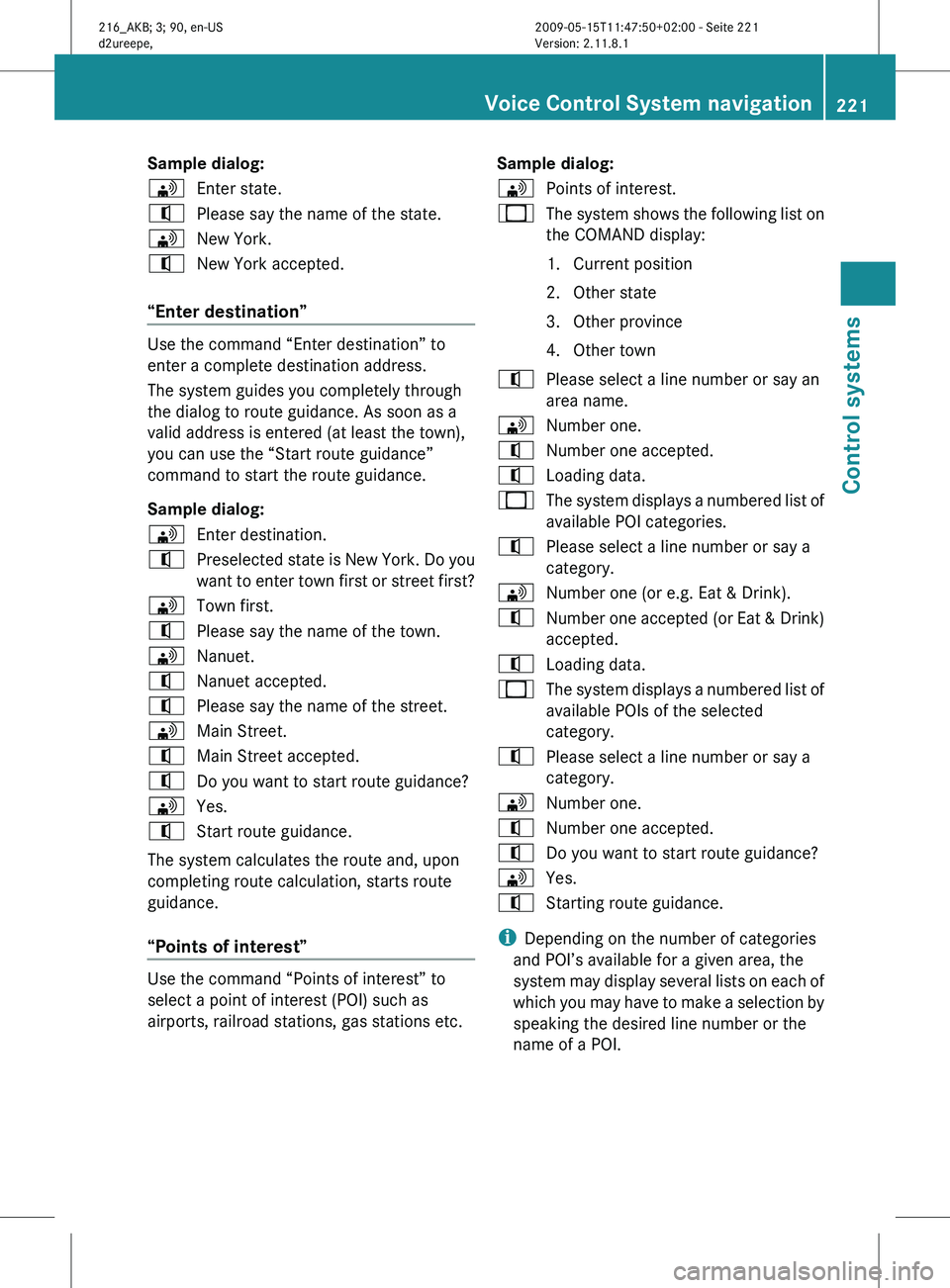
Sample dialog:
\
Enter state.
^ Please say the name of the state.
\ New York.
^ New York accepted.
“Enter destination” Use the command “Enter destination” to
enter a complete destination address.
The system guides you completely through
the dialog to route guidance. As soon as a
valid address is entered (at least the town),
you can use the “Start route guidance”
command to start the route guidance.
Sample dialog:
\
Enter destination.
^ Preselected state is New York. Do you
want to
enter town first or street first?
\ Town first.
^ Please say the name of the town.
\ Nanuet.
^ Nanuet accepted.
^ Please say the name of the street.
\ Main Street.
^ Main Street accepted.
^ Do you want to start route guidance?
\ Yes.
^ Start route guidance.
The system calculates the route and, upon
completing route calculation, starts route
guidance.
“Points of interest” Use the command “Points of interest” to
select a point of interest (POI) such as
airports, railroad stations, gas stations etc. Sample dialog:
\
Points of interest.
_ The system shows the following list on
the COMAND display:
1.Current position
2.
Other state
3. Other province
4. Other town
^ Please select a line number or say an
area name.
\ Number one.
^ Number one accepted.
^ Loading data.
_ The system displays a numbered list of
available POI categories.
^ Please select a line number or say a
category.
\ Number one (or e.g. Eat & Drink).
^ Number one accepted (or Eat & Drink)
accepted.
^ Loading data.
_ The system displays a numbered list of
available POIs of the selected
category.
^ Please select a line number or say a
category.
\ Number one.
^ Number one accepted.
^ Do you want to start route guidance?
\ Yes.
^ Starting route guidance.
i Depending on the number of categories
and POI’s available for a given area, the
system may
display several lists on each of
which you may have to make a selection by
speaking the desired line number or the
name of a POI. Voice Control System navigation
221
Control systems
216_AKB; 3; 90, en-US
d2ureepe, Version: 2.11.8.1 2009-05-15T11:47:50+02:00 - Seite 221 Z
Page 224 of 500
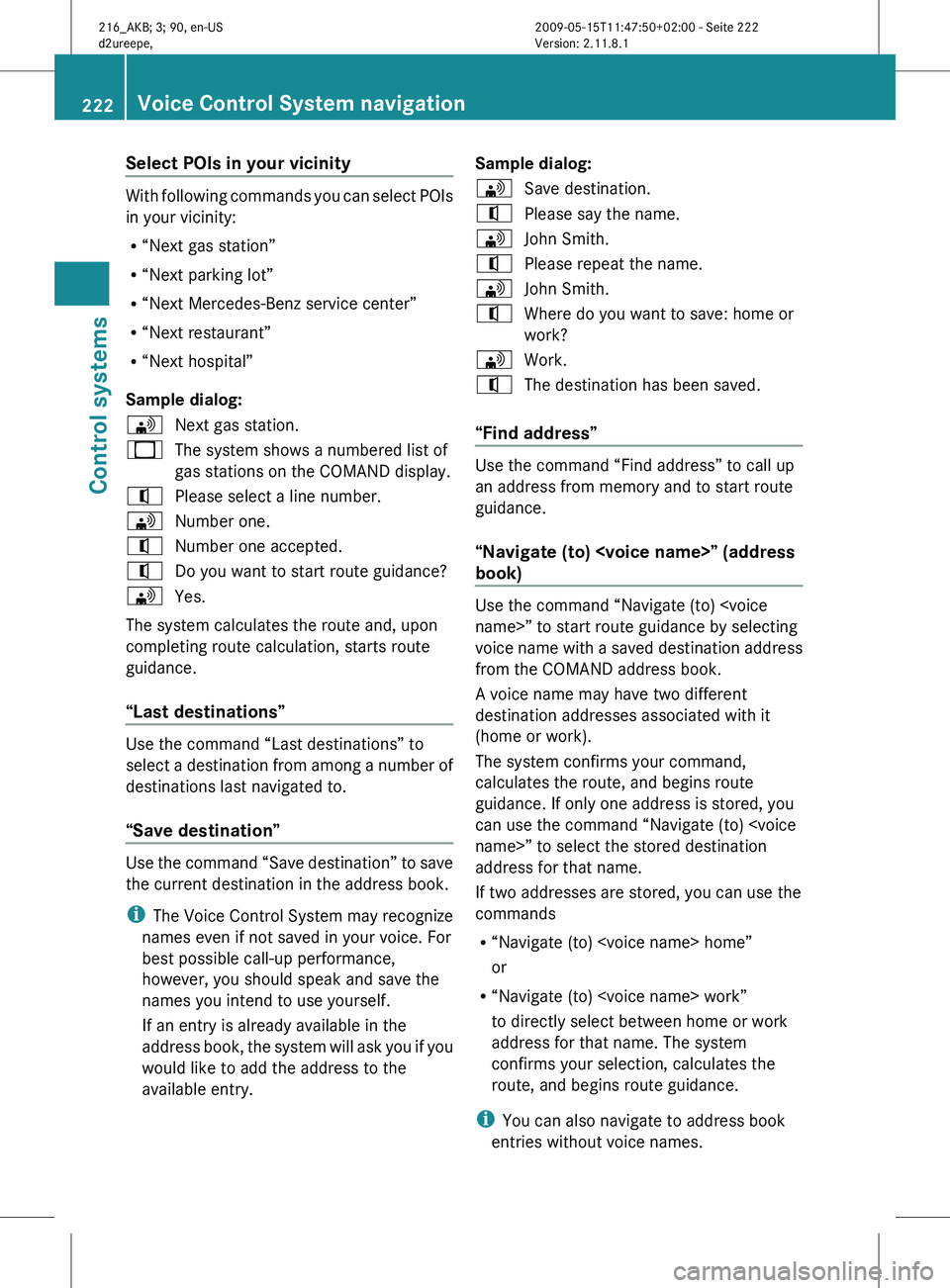
Select POIs in your vicinity
With following commands you can select POIs
in your vicinity:
R
“Next gas station”
R “Next parking lot”
R “Next Mercedes-Benz service center”
R “Next restaurant”
R “Next hospital”
Sample dialog:
\ Next gas station.
_ The system shows a numbered list of
gas stations on the COMAND display.
^ Please select a line number.
\ Number one.
^ Number one accepted.
^ Do you want to start route guidance?
\ Yes.
The system calculates the route and, upon
completing route calculation, starts route
guidance.
“Last destinations” Use the command “Last destinations” to
select
a
destination from among a number of
destinations last navigated to.
“Save destination” Use the command “Save destination” to save
the current destination in the address book.
i
The Voice
Control System may recognize
names even if not saved in your voice. For
best possible call-up performance,
however, you should speak and save the
names you intend to use yourself.
If an entry is already available in the
address book, the system will ask you if you
would like to add the address to the
available entry. Sample dialog:
\
Save destination.
^ Please say the name.
\ John Smith.
^ Please repeat the name.
\ John Smith.
^ Where do you want to save: home or
work?
\ Work.
^ The destination has been saved.
“Find address” Use the command “Find address” to call up
an address from memory and to start route
guidance.
“Navigate (to)
book)
Use the command “Navigate (to)
voice
name
with a saved destination address
from the COMAND address book.
A voice name may have two different
destination addresses associated with it
(home or work).
The system confirms your command,
calculates the route, and begins route
guidance. If only one address is stored, you
can use the command “Navigate (to)
address for that name.
If two addresses are stored, you can use the
commands
R “Navigate (to)
or
R “Navigate (to)
to directly select between home or work
address for that name. The system
confirms your selection, calculates the
route, and begins route guidance.
i You can also navigate to address book
entries without voice names. 222
Voice Control System navigation
Control systems
216_AKB; 3; 90, en-US
d2ureepe,
Version: 2.11.8.1 2009-05-15T11:47:50+02:00 - Seite 222
Page 225 of 500
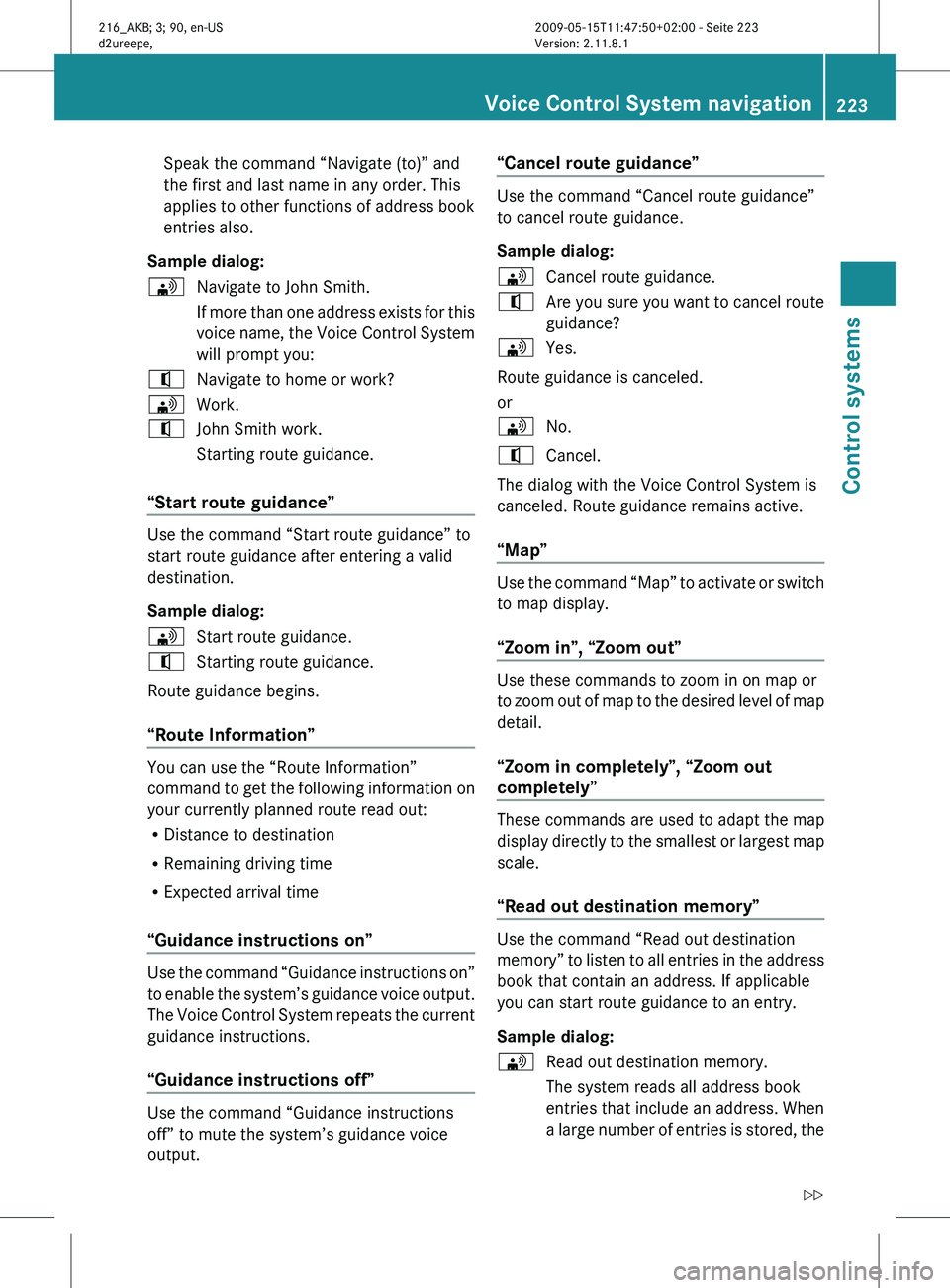
Speak the command “Navigate (to)” and
the first and last name in any order. This
applies to other functions of address book
entries also.
Sample dialog:
\ Navigate to John Smith.
If more
than one address exists for this
voice name, the Voice Control System
will prompt you:
^ Navigate to home or work?
\ Work.
^ John Smith work.
Starting route guidance.
“Start route guidance” Use the command “Start route guidance” to
start route guidance after entering a valid
destination.
Sample dialog:
\
Start route guidance.
^ Starting route guidance.
Route guidance begins.
“Route Information” You can use the “Route Information”
command
to
get the following information on
your currently planned route read out:
R Distance to destination
R Remaining driving time
R Expected arrival time
“Guidance instructions on” Use the command “Guidance instructions on”
to
enable
the system’s guidance voice output.
The Voice Control System repeats the current
guidance instructions.
“Guidance instructions off” Use the command “Guidance instructions
off” to mute the system’s guidance voice
output. “Cancel route guidance” Use the command “Cancel route guidance”
to cancel route guidance.
Sample dialog:
\
Cancel route guidance.
^ Are you sure you want to cancel route
guidance?
\ Yes.
Route guidance is canceled.
or
\ No.
^ Cancel.
The dialog with the Voice Control System is
canceled. Route guidance remains active.
“Map” Use the command “Map” to activate or switch
to map display.
“Zoom in”, “Zoom out”
Use these commands to zoom in on map or
to
zoom
out of map to the desired level of map
detail.
“Zoom in completely”, “Zoom out
completely” These commands are used to adapt the map
display
directly
to the smallest or largest map
scale.
“Read out destination memory” Use the command “Read out destination
memory”
to
listen to all entries in the address
book that contain an address. If applicable
you can start route guidance to an entry.
Sample dialog:
\ Read out destination memory.
The system reads all address book
entries that include an address. When
a large
number of entries is stored, the Voice Control System navigation
223
Control systems
216_AKB; 3; 90, en-US
d2ureepe, Version: 2.11.8.1 2009-05-15T11:47:50+02:00 - Seite 223 Z
Page 226 of 500
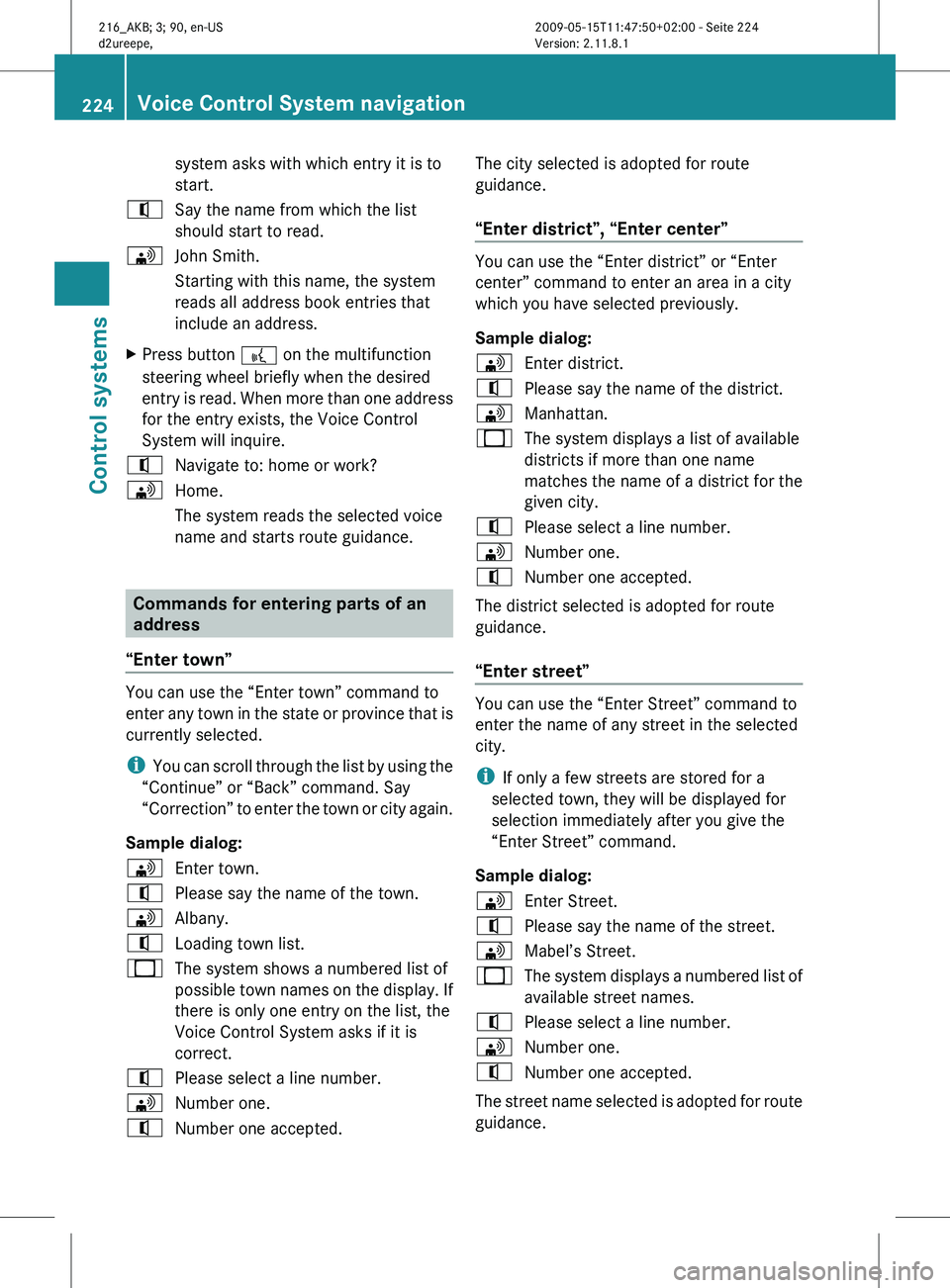
system asks with which entry it is to
start.
^ Say the name from which the list
should start to read.
\ John Smith.
Starting with this name, the system
reads all address book entries that
include an address.
X Press button ? on the multifunction
steering wheel briefly when the desired
entry is
read. When more than one address
for the entry exists, the Voice Control
System will inquire.
^ Navigate to: home or work?
\ Home.
The system reads the selected voice
name and starts route guidance. Commands for entering parts of an
address
“Enter town” You can use the “Enter town” command to
enter
any
town in the state or province that is
currently selected.
i You can scroll through the list by using the
“Continue” or “Back” command. Say
“Correction” to enter the town or city again.
Sample dialog:
\ Enter town.
^ Please say the name of the town.
\ Albany.
^ Loading town list.
_ The system shows a numbered list of
possible town
names on the display. If
there is only one entry on the list, the
Voice Control System asks if it is
correct.
^ Please select a line number.
\ Number one.
^ Number one accepted. The city selected is adopted for route
guidance.
“Enter district”, “Enter center” You can use the “Enter district” or “Enter
center” command to enter an area in a city
which you have selected previously.
Sample dialog:
\
Enter district.
^ Please say the name of the district.
\ Manhattan.
_ The system displays a list of available
districts if more than one name
matches the name of a district for the
given city.
^ Please select a line number.
\ Number one.
^ Number one accepted.
The district selected is adopted for route
guidance.
“Enter street” You can use the “Enter Street” command to
enter the name of any street in the selected
city.
i
If only a few streets are stored for a
selected town, they will be displayed for
selection immediately after you give the
“Enter Street” command.
Sample dialog:
\ Enter Street.
^ Please say the name of the street.
\ Mabel’s Street.
_ The system displays a numbered list of
available street names.
^ Please select a line number.
\ Number one.
^ Number one accepted.
The street name selected is adopted for route
guidance. 224
Voice Control System navigation
Control systems
216_AKB; 3; 90, en-US
d2ureepe,
Version: 2.11.8.1 2009-05-15T11:47:50+02:00 - Seite 224
Page 227 of 500
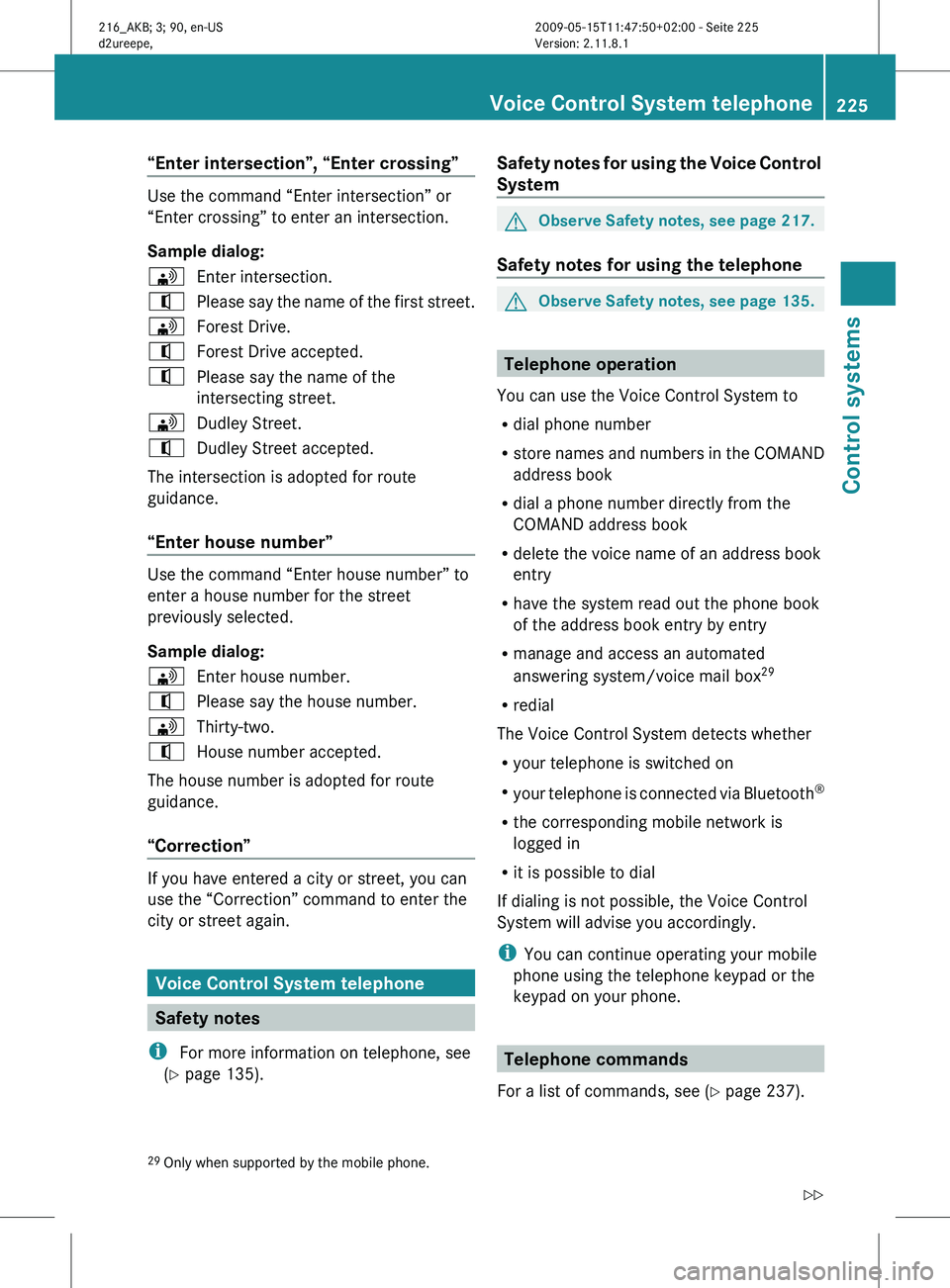
“Enter intersection”, “Enter crossing”
Use the command “Enter intersection” or
“Enter crossing” to enter an intersection.
Sample dialog:
\
Enter intersection.
^ Please say the name of the first street.
\ Forest Drive.
^ Forest Drive accepted.
^ Please say the name of the
intersecting street.
\ Dudley Street.
^ Dudley Street accepted.
The intersection is adopted for route
guidance.
“Enter house number” Use the command “Enter house number” to
enter a house number for the street
previously selected.
Sample dialog:
\
Enter house number.
^ Please say the house number.
\ Thirty-two.
^ House number accepted.
The house number is adopted for route
guidance.
“Correction” If you have entered a city or street, you can
use the “Correction” command to enter the
city or street again.
Voice Control System telephone
Safety notes
i For more information on telephone, see
(Y page 135). Safety notes for using the Voice Control
System G
Observe Safety notes, see page 217.
Safety notes for using the telephone G
Observe Safety notes, see page 135. Telephone operation
You can use the Voice Control System to
R dial phone number
R store names
and numbers in the COMAND
address book
R dial a phone number directly from the
COMAND address book
R delete the voice name of an address book
entry
R have the system read out the phone book
of the address book entry by entry
R manage and access an automated
answering system/voice mail box 29
R redial
The Voice Control System detects whether
R your telephone is switched on
R your telephone is connected via Bluetooth ®
R the corresponding mobile network is
logged in
R it is possible to dial
If dialing is not possible, the Voice Control
System will advise you accordingly.
i You can continue operating your mobile
phone using the telephone keypad or the
keypad on your phone. Telephone commands
For a list of commands, see ( Y page 237).
29 Only when supported by the mobile phone. Voice Control System telephone
225
Control systems
216_AKB; 3; 90, en-US
d2ureepe, Version: 2.11.8.1 2009-05-15T11:47:50+02:00 - Seite 225 Z
Page 228 of 500
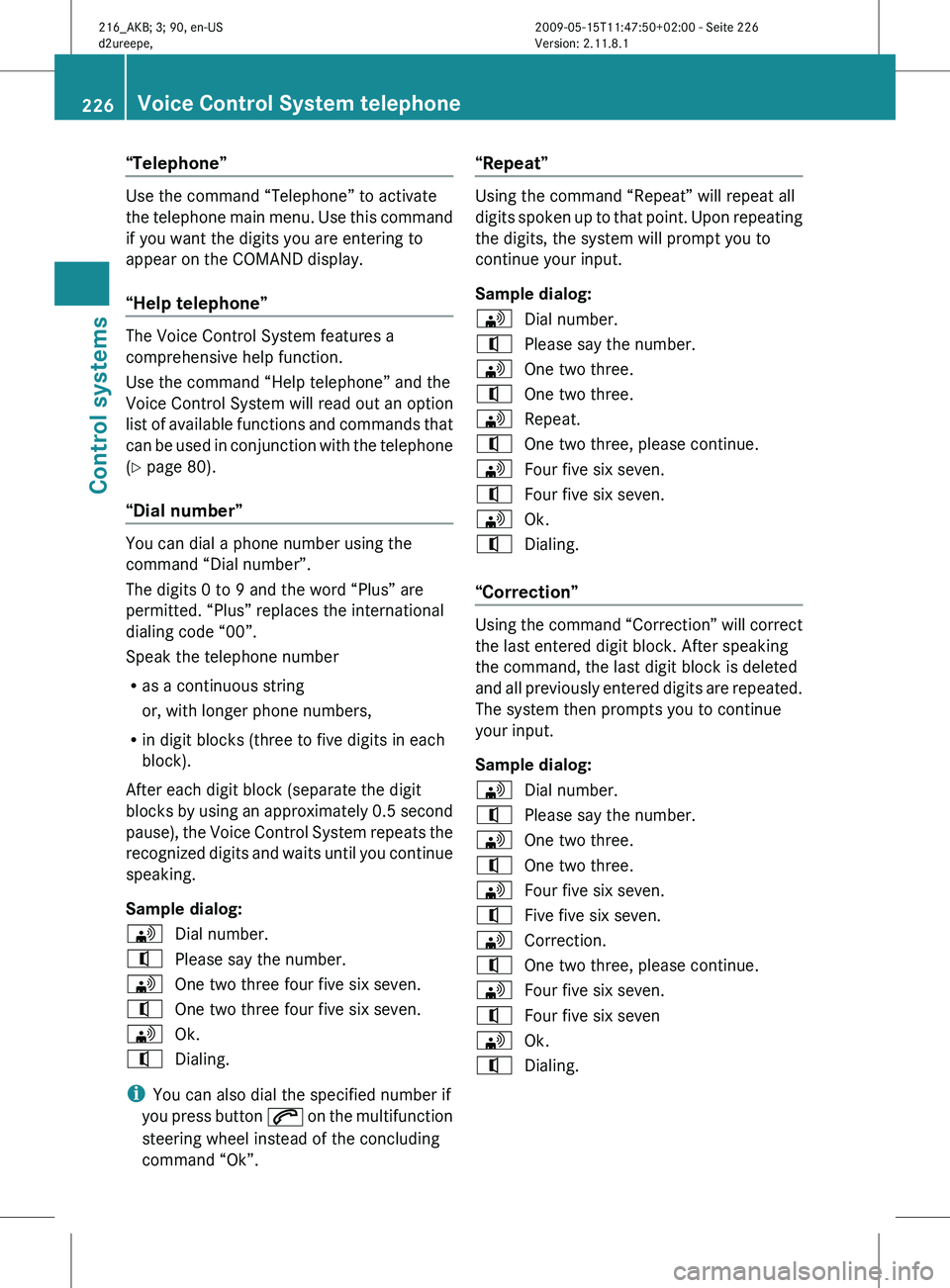
“Telephone”
Use the command “Telephone” to activate
the
telephone
main menu. Use this command
if you want the digits you are entering to
appear on the COMAND display.
“Help telephone” The Voice Control System features a
comprehensive help function.
Use the command “Help telephone” and the
Voice Control System will read out an option
list
of
available functions and commands that
can be used in conjunction with the telephone
(Y page 80).
“Dial number” You can dial a phone number using the
command “Dial number”.
The digits 0 to 9 and the word “Plus” are
permitted. “Plus” replaces the international
dialing code “00”.
Speak the telephone number
R
as a continuous string
or, with longer phone numbers,
R in digit blocks (three to five digits in each
block).
After each digit block (separate the digit
blocks by
using an approximately 0.5 second
pause), the Voice Control System repeats the
recognized digits and waits until you continue
speaking.
Sample dialog:
\ Dial number.
^ Please say the number.
\ One two three four five six seven.
^ One two three four five six seven.
\ Ok.
^ Dialing.
i You can also dial the specified number if
you press
button 6 on the multifunction
steering wheel instead of the concluding
command “Ok”. “Repeat” Using the command “Repeat” will repeat all
digits
spoken
up to that point. Upon repeating
the digits, the system will prompt you to
continue your input.
Sample dialog:
\ Dial number.
^ Please say the number.
\ One two three.
^ One two three.
\ Repeat.
^ One two three, please continue.
\ Four five six seven.
^ Four five six seven.
\ Ok.
^ Dialing.
“Correction” Using the command “Correction” will correct
the last entered digit block. After speaking
the command, the last digit block is deleted
and
all
previously entered digits are repeated.
The system then prompts you to continue
your input.
Sample dialog:
\ Dial number.
^ Please say the number.
\ One two three.
^ One two three.
\ Four five six seven.
^ Five five six seven.
\ Correction.
^ One two three, please continue.
\ Four five six seven.
^ Four five six seven
\ Ok.
^ Dialing. 226
Voice Control System telephone
Control systems
216_AKB; 3; 90, en-US
d2ureepe,
Version: 2.11.8.1 2009-05-15T11:47:50+02:00 - Seite 226
Page 229 of 500
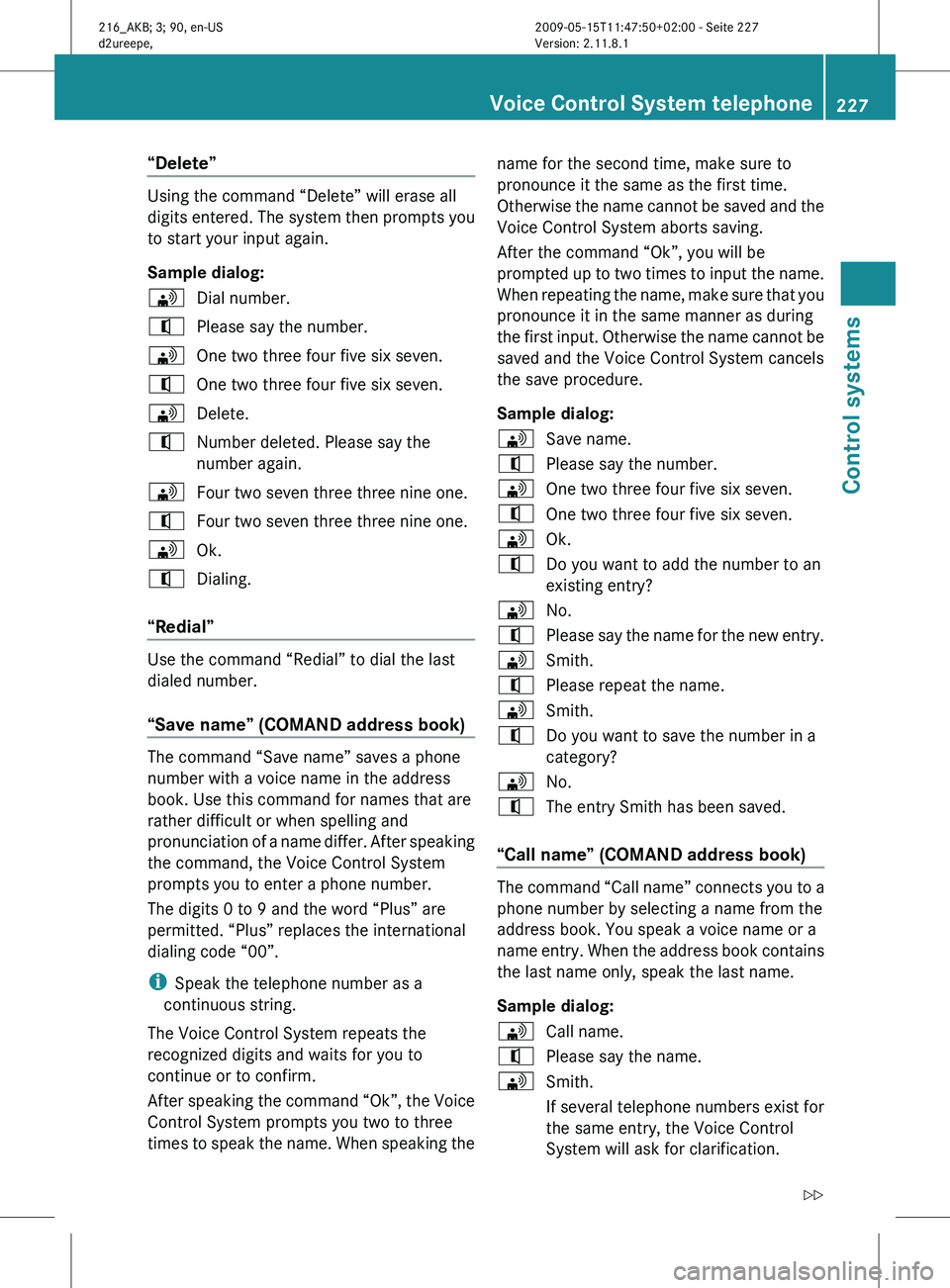
“Delete”
Using the command “Delete” will erase all
digits
entered.
The system then prompts you
to start your input again.
Sample dialog:
\ Dial number.
^ Please say the number.
\ One two three four five six seven.
^ One two three four five six seven.
\ Delete.
^ Number deleted. Please say the
number again.
\ Four two seven three three nine one.
^ Four two seven three three nine one.
\ Ok.
^ Dialing.
“Redial” Use the command “Redial” to dial the last
dialed number.
“Save name” (COMAND address book)
The command “Save name” saves a phone
number with a voice name in the address
book. Use this command for names that are
rather difficult or when spelling and
pronunciation
of
a name differ. After speaking
the command, the Voice Control System
prompts you to enter a phone number.
The digits 0 to 9 and the word “Plus” are
permitted. “Plus” replaces the international
dialing code “00”.
i Speak the telephone number as a
continuous string.
The Voice Control System repeats the
recognized digits and waits for you to
continue or to confirm.
After speaking the command “Ok”, the Voice
Control System prompts you two to three
times to speak the name. When speaking the name for the second time, make sure to
pronounce it the same as the first time.
Otherwise the
name cannot be saved and the
Voice Control System aborts saving.
After the command “Ok”, you will be
prompted up to two times to input the name.
When repeating the name, make sure that you
pronounce it in the same manner as during
the first input. Otherwise the name cannot be
saved and the Voice Control System cancels
the save procedure.
Sample dialog:
\ Save name.
^ Please say the number.
\ One two three four five six seven.
^ One two three four five six seven.
\ Ok.
^ Do you want to add the number to an
existing entry?
\ No.
^ Please say the name for the new entry.
\ Smith.
^ Please repeat the name.
\ Smith.
^ Do you want to save the number in a
category?
\ No.
^ The entry Smith has been saved.
“Call name” (COMAND address book) The command “Call name” connects you to a
phone number by selecting a name from the
address book. You speak a voice name or a
name
entry.
When the address book contains
the last name only, speak the last name.
Sample dialog:
\ Call name.
^ Please say the name.
\ Smith.
If several telephone numbers exist for
the same entry, the Voice Control
System will ask for clarification. Voice Control System telephone
227
Control systems
216_AKB; 3; 90, en-US
d2ureepe, Version: 2.11.8.1 2009-05-15T11:47:50+02:00 - Seite 227 Z
Page 230 of 500
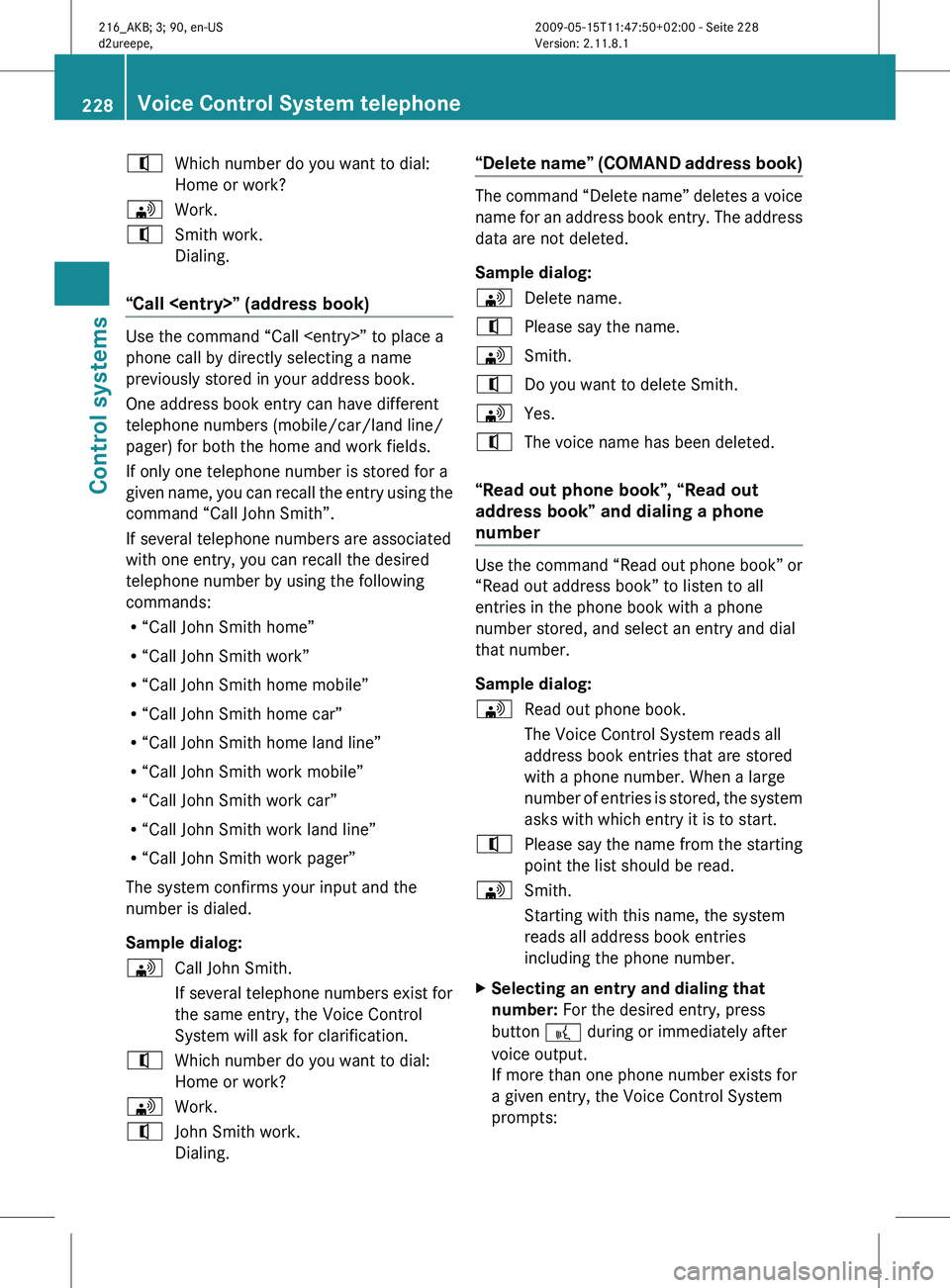
^
Which number do you want to dial:
Home or work?
\ Work.
^ Smith work.
Dialing.
“Call
phone call by directly selecting a name
previously stored in your address book.
One address book entry can have different
telephone numbers (mobile/car/land line/
pager) for both the home and work fields.
If only one telephone number is stored for a
given
name,
you can recall the entry using the
command “Call John Smith”.
If several telephone numbers are associated
with one entry, you can recall the desired
telephone number by using the following
commands:
R “Call John Smith home”
R “Call John Smith work”
R “Call John Smith home mobile”
R “Call John Smith home car”
R “Call John Smith home land line”
R “Call John Smith work mobile”
R “Call John Smith work car”
R “Call John Smith work land line”
R “Call John Smith work pager”
The system confirms your input and the
number is dialed.
Sample dialog:
\ Call John Smith.
If several telephone numbers exist for
the same entry, the Voice Control
System will ask for clarification.
^ Which number do you want to dial:
Home or work?
\ Work.
^ John Smith work.
Dialing. “Delete name” (COMAND address book) The command “Delete name” deletes a voice
name
for
an address book entry. The address
data are not deleted.
Sample dialog:
\ Delete name.
^ Please say the name.
\ Smith.
^ Do you want to delete Smith.
\ Yes.
^ The voice name has been deleted.
“Read out phone book”, “Read out
address book” and dialing a phone
number Use the command “Read out phone book” or
“Read out address book” to listen to all
entries in the phone book with a phone
number stored, and select an entry and dial
that number.
Sample dialog:
\
Read out phone book.
The Voice Control System reads all
address book entries that are stored
with a phone number. When a large
number of
entries is stored, the system
asks with which entry it is to start.
^ Please say the name from the starting
point the list should be read.
\ Smith.
Starting with this name, the system
reads all address book entries
including the phone number.
X Selecting an entry and dialing that
number: For the desired entry, press
button ? during or immediately after
voice output.
If more than one phone number exists for
a given entry, the Voice Control System
prompts: 228
Voice Control System telephone
Control systems
216_AKB; 3; 90, en-US
d2ureepe,
Version: 2.11.8.1 2009-05-15T11:47:50+02:00 - Seite 228